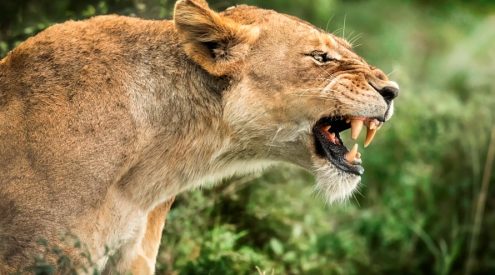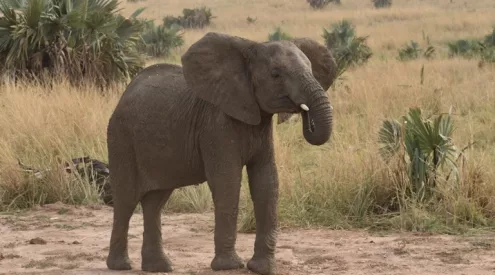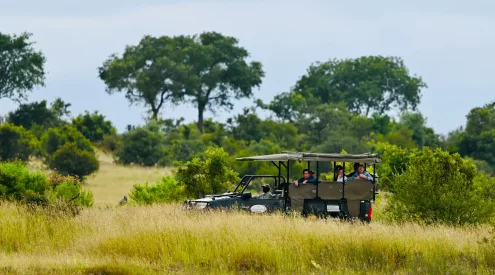The rapid rise of elephant deaths due to poaching in Africa make a tuskless carcass a familiar sight. Behind the protective boundaries of the Moremi Game Reserve, photographer Rory Bruins came across the remains of a bull elephant, dignified in death with its tusks in place.

White-backed vultures thrive off the carcass of an elephant in the Moremi Game Reserve in Botswana. © Rory Bruins
The lives of elephants parallel those of humans in their socially aware nature, developmental stages of life, loyalty and friendships, life-long memories, and mourning of their dead. Culling operations – a controversial method of controlling elephant populations where they are most dense – have to be meticulously carried out so that the social dynamics of a herd are not knocked off track with the loss of a significant member. The death of an elephant in nature is the end of a long life, a large life, one with singular ecological importance and one that is lamented by herd members left behind.
These days, one of these huge, heart-felt deaths occurs every fifteen minutes in Africa. So unnatural and causing such destruction, the poaching of elephants for their ivory has reached an all-time high. The wild world of nature is brutal enough as it is, often leaving healthy animals banished, injured or dead in a fight for survival or dominance. Seeing an elephant die naturally, with its tusks intact and its remains feeding hungry carnivores, is something quite wonderful in today’s reality. These sightings were spotted in Botswana’s Moremi Game Reserve.

An elephant having died with dignity, retains its tusks, which are in fact enlarged incisors that are embedded in their skulls. © Rory Bruins
Elephants have few predators other than humans; the biggest natural threat being the lion, followed by hyenas, which target the young. There have been few of these attacks documented, and there is probably more evidence of elephants chasing lions, but when an elephant is taken down, it provides enough sustenance for not only the lion pride responsible for its death, but for lower level predators, scavengers and decomposers that wait their turn.
In life, elephants are integral to the ecosystem. They are the driving force in ‘bushveld maintenance’, keeping woodlands neatly trimmed, and where they tear down existing trees, they disperse new seeds in their faecal matter. Their dung provides for dung beetles, and (if alone and lost in the bush) it can provide for humans too. The amount of water an elephant drinks and its poor digestive system means that what goes in comes out in pretty much the same form. Enough water can be extracted from their fresh dung to sustain a thirsty (and open-minded!) traveller, while their sundried dung is a renowned fire-starter. Fallen trees (a result of elephants’ destructive feeding and social dominance behaviour) bring the green leaves from the tallest treetops down for the shorter browsing animals to feed on, like black rhino and various antelope. The natural decay of these fallen trees is decomposed and re-injected into the earth, while tiny ecosystems develop in the environments created in the perished trees.

Elephant bulls can weigh up to six tonnes and as they age, their tusks become less used and can grow into elegant adornments of ivory. © Rory Bruins

Elephants use their muscular trunks for some of the most important tasks in life, and they gain incredible control over them; however, it takes calves around 3 months of clumsy flopping to get it right. © Rory Bruins
After a lifetime of raising calves, imprinting on young bulls, teaching their descendants, moulding migration routes and impacting the earth like no other mammal could; elephants grow old, and their eroded teeth prevent them from feeding. At around 60 years old, the natural death of an elephant is one of starvation. Throughout life, these giants will have made their way through 6 sets of molars, which eventually stop replacing themselves and great old bulls and cows keep themselves hydrated for as long as their famished bodies can stand. Eventually, naturally, old elephants are too weak to fight off predators or they die quietly near a watering hole, before their bodies are taken by the hungry.
The concept of an ‘elephant graveyard’, illustrated in Disney’s The Lion King as a valley of elephant skeletons, has rather a sensible origin. It is common for elephants to make their way towards water in their dying days. Somewhere to keep cool and hydrated. Often elephants from the same herd, or in the same parks, will go to the same waterhole to die, and a collection of their bones in a riverbed or at a waterhole has become known as an ‘elephant graveyard’.

Elephants grow six sets of molars in their lifetime, which are worn down consistently from the bark and branches they eat. Once the last pair of molars has worn down, at around 60 years old, elephants die of starvation. © Rory Bruins
There are stories about elephants that revisit the grave sites of their dead ancestors, and it has been documented that herds passing the body of a deceased individual will pick up the bones and carry them for a while, or merely place a reassuring trunk onto the dead body, as if to acknowledge the death and pay respect. This sort of sincere reaction to familial passing only scrapes the surface of the deep reality of elephant emotions. Their impact on Africa is irreplaceable. Let us see them die with their ivory.

Male elephants break away from their herds at puberty (12-14 years old) and either wander alone looking for females, or join bachelor herds. These young bulls, called ‘askaris’ are taught the ways of the world by older bulls and with age, the former askaris will protect their old mentors from danger. © Rory Bruins

If elephant herds become too large they may split up. The separated herds remain in contact due to their relatedness. © Rory Bruins
This post is brought to you by Sun Destinations, who handle the marketing and reservations for a selection of Africa’s Hidden Secrets. Check out Sun Destinations on Google+ and Sun Safaris on Facebook, Twitter, and Pinterest.





















